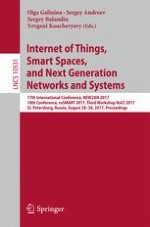This book constitutes the joint refereed proceedings of the 17th International Conference on Next Generation Wired/Wireless Advanced Networks and Systems, NEW2AN 2017, the 10th Conference on Internet of Things and Smart Spaces, ruSMART 2017.
The 71 revised full papers presented were carefully reviewed and selected from 202 submissions. The papers of NEW2AN focus on advanced wireless networking and applications; lower-layer communication enablers; novel and innovative approaches to performance and efficiency analysis of ad-hoc and machine-type systems; employed game-theoretical formulations, Markov chain models, and advanced queuing theory; grapheme and other emerging material, photonics and optics; generation and processing of signals; and business aspects. The ruSMART papers deal with fully-customized applications and services. The NsCC Workshop papers capture the current state-of-the-art in the field of molecular a
nd
nanoscale communications such as information, communication and network theoretical analysis of molecular and nanonetwork, mobility in molecular and nanonetworks; novel and practical communication protocols; routing schemes and architectures; design/engineering/evaluation of molecular and nonoscale communication systems; potential applications and interconnections to the Internet (e.g. the Internet of Nano Things).
